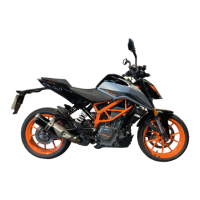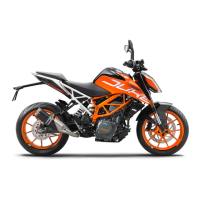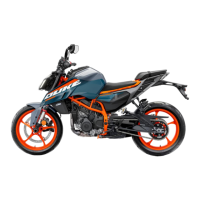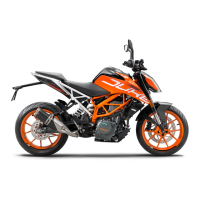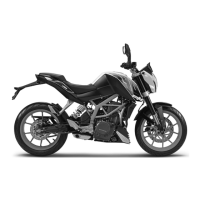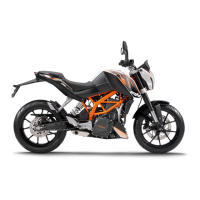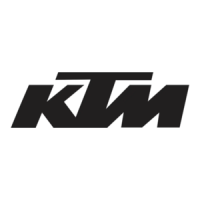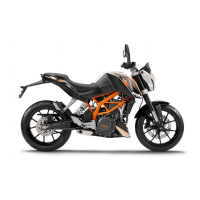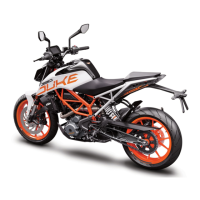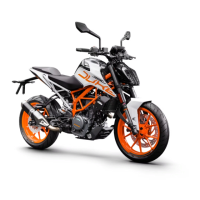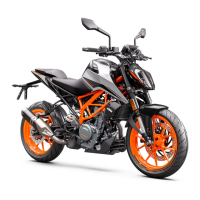Do you have a question about the KTM 390 DUKE 2022 and is the answer not in the manual?
Provides crucial safety guidelines for operating the motorcycle, including dangers of accidents and poisoning.
Highlights the importance of wearing appropriate protective clothing for rider safety.
Shows the location of the vehicle identification number on the steering head.
Indicates the location of the vehicle's type label on the frame.
Shows the location of the engine number on the engine casing.
Explains where to find the key number for ordering replacement keys.
Details the emergency OFF switch and start button on the right handlebar.
Details the combination switch, light switch, menu buttons, turn signal, and horn button.
Explains the types of warnings (yellow, red) displayed on the instrument and how to hide them.
Details the various elements and indicators shown on the combination instrument's display.
Guides on activating or deactivating the Quick Shift+ function and setting engine speed thresholds.
Provides information about the various indicator lamps on the instrument panel.
Guides on navigating the instrument's menu system using the buttons.
Guides on accessing and navigating stored warnings and error messages.
Explains how to access and select different ABS modes.
Provides essential advice and checks before riding the motorcycle for the first time.
Details the procedure and precautions for running in the engine during the initial period.
Offers warnings and guidelines for safely loading luggage onto the motorcycle.
Lists crucial pre-ride checks and maintenance tasks to ensure roadworthiness.
Guides on how to start riding the motorcycle from a standstill, including clutch and throttle control.
Explains how to use the optional Quickshifter+ for clutchless gear changes.
Provides essential instructions and warnings for effective and safe braking techniques.
Details procedures and safety measures for stopping and parking the motorcycle.
Provides detailed instructions and safety warnings for starting the motorcycle's engine.
Offers advice and warnings on gear shifting, riding techniques, and passenger safety.
Details the correct procedure for refueling, including fire and health hazard warnings.
Lists the essential maintenance tasks required at different service intervals.
Guides on adjusting the rear shock absorber's spring preload for optimal suspension performance.
Provides instructions for properly cleaning the motorcycle chain, including safety and environmental notes.
Details the procedure for adjusting the chain tension, including aligning the rear wheel.
Guides on inspecting the chain, rear sprocket, and engine sprocket for wear.
Explains how to check and adjust the motorcycle chain tension for optimal performance and safety.
Explains the function, operation, and warnings related to the ABS system.
Details the procedure for adding front brake fluid, including safety warnings.
Guides on checking the front brake linings for minimum thickness and wear.
Explains how to check the foot brake lever's free travel and its importance for the brake system.
Details the procedure for adjusting the foot brake lever's free travel.
Details the procedure for adding rear brake fluid, including safety warnings.
Guides on checking the rear brake linings for minimum thickness and wear.
Guides on checking the thickness and condition of the brake discs.
Explains how to check the rear brake fluid level and related warnings.
Explains how to check the front brake fluid level and related warnings.
Details the procedure for safely removing the front wheel.
Details the procedure for safely installing the front wheel.
Details the procedure for safely removing the rear wheel.
Details the procedure for safely installing the rear wheel.
Provides guidelines for checking tire condition, including cuts, tread depth, and age.
Explains how to check and set the correct tire pressure for solo and passenger riding.
Provides instructions for charging the 12-V battery, including safety and method guidelines.
Details the procedure for changing the main fuse, including location and safety warnings.
Guides on changing the ABS fuses, explaining their location and purpose.
Explains how to change fuses for various electrical components and lists fuse assignments.
Explains how to check the coolant level in the compensating tank and radiator, including safety warnings.
Details the procedure for changing the motorcycle's coolant, including safety warnings.
Details the procedure for checking coolant level and antifreeze protection, including safety warnings.
Explains how to check the engine oil level, including oil markings and precautions.
Details the procedure for adding engine oil, including important notes on oil quality and mixing.
Provides a comprehensive guide to changing engine oil, oil filter, and cleaning oil screens.
Provides detailed instructions for cleaning the motorcycle, including safety and environmental considerations.
Details the steps required for properly storing the motorcycle for extended periods.
Guides on the necessary steps to take the motorcycle out of storage and prepare it for riding.
Lists common faults, their possible causes, and recommended actions for resolution.
Provides crucial safety guidelines for operating the motorcycle, including dangers of accidents and poisoning.
Highlights the importance of wearing appropriate protective clothing for rider safety.
Shows the location of the vehicle identification number on the steering head.
Indicates the location of the vehicle's type label on the frame.
Shows the location of the engine number on the engine casing.
Explains where to find the key number for ordering replacement keys.
Details the emergency OFF switch and start button on the right handlebar.
Details the combination switch, light switch, menu buttons, turn signal, and horn button.
Explains the types of warnings (yellow, red) displayed on the instrument and how to hide them.
Details the various elements and indicators shown on the combination instrument's display.
Guides on activating or deactivating the Quick Shift+ function and setting engine speed thresholds.
Provides information about the various indicator lamps on the instrument panel.
Guides on navigating the instrument's menu system using the buttons.
Guides on accessing and navigating stored warnings and error messages.
Explains how to access and select different ABS modes.
Provides essential advice and checks before riding the motorcycle for the first time.
Details the procedure and precautions for running in the engine during the initial period.
Offers warnings and guidelines for safely loading luggage onto the motorcycle.
Lists crucial pre-ride checks and maintenance tasks to ensure roadworthiness.
Guides on how to start riding the motorcycle from a standstill, including clutch and throttle control.
Explains how to use the optional Quickshifter+ for clutchless gear changes.
Provides essential instructions and warnings for effective and safe braking techniques.
Details procedures and safety measures for stopping and parking the motorcycle.
Provides detailed instructions and safety warnings for starting the motorcycle's engine.
Offers advice and warnings on gear shifting, riding techniques, and passenger safety.
Details the correct procedure for refueling, including fire and health hazard warnings.
Lists the essential maintenance tasks required at different service intervals.
Guides on adjusting the rear shock absorber's spring preload for optimal suspension performance.
Provides instructions for properly cleaning the motorcycle chain, including safety and environmental notes.
Details the procedure for adjusting the chain tension, including aligning the rear wheel.
Guides on inspecting the chain, rear sprocket, and engine sprocket for wear.
Explains how to check and adjust the motorcycle chain tension for optimal performance and safety.
Explains the function, operation, and warnings related to the ABS system.
Details the procedure for adding front brake fluid, including safety warnings.
Guides on checking the front brake linings for minimum thickness and wear.
Explains how to check the foot brake lever's free travel and its importance for the brake system.
Details the procedure for adjusting the foot brake lever's free travel.
Details the procedure for adding rear brake fluid, including safety warnings.
Guides on checking the rear brake linings for minimum thickness and wear.
Guides on checking the thickness and condition of the brake discs.
Explains how to check the rear brake fluid level and related warnings.
Explains how to check the front brake fluid level and related warnings.
Details the procedure for safely removing the front wheel.
Details the procedure for safely installing the front wheel.
Details the procedure for safely removing the rear wheel.
Details the procedure for safely installing the rear wheel.
Provides guidelines for checking tire condition, including cuts, tread depth, and age.
Explains how to check and set the correct tire pressure for solo and passenger riding.
Provides instructions for charging the 12-V battery, including safety and method guidelines.
Details the procedure for changing the main fuse, including location and safety warnings.
Guides on changing the ABS fuses, explaining their location and purpose.
Explains how to change fuses for various electrical components and lists fuse assignments.
Explains how to check the coolant level in the compensating tank and radiator, including safety warnings.
Details the procedure for changing the motorcycle's coolant, including safety warnings.
Details the procedure for checking coolant level and antifreeze protection, including safety warnings.
Explains how to check the engine oil level, including oil markings and precautions.
Details the procedure for adding engine oil, including important notes on oil quality and mixing.
Provides a comprehensive guide to changing engine oil, oil filter, and cleaning oil screens.
Provides detailed instructions for cleaning the motorcycle, including safety and environmental considerations.
Details the steps required for properly storing the motorcycle for extended periods.
Guides on the necessary steps to take the motorcycle out of storage and prepare it for riding.
Lists common faults, their possible causes, and recommended actions for resolution.
| Displacement | 373.2 cc |
|---|---|
| Bore x Stroke | 89 mm x 60 mm |
| Compression Ratio | 12.6:1 |
| Fuel System | Electronic Fuel Injection |
| Cooling System | Liquid cooled |
| Transmission | 6-speed |
| Frame | Steel trellis frame, powder coated |
| Front Suspension | WP APEX 43 |
| Rear Suspension | WP APEX Monoshock |
| Front Tire | 110/70 ZR17 |
| Rear Tire | 150/60 ZR17 |
| Seat Height | 830 mm |
| Fuel Tank Capacity | 13.4 liters |
| Dry Weight | 150 kg |
| Instruments | TFT display |
| Headlight | LED |
| Tail Light | LED |
| Engine Type | Single cylinder, 4-stroke |
| Power | 32 kW (44 hp) |
| Torque | 37 Nm |
| Front Brake | 320 mm disc, four-piston radial fixed caliper |
| Rear Brake | 230 mm disc, single-piston floating caliper |
| Wheelbase | 1357 mm |
| ABS | Bosch 9.1MB Two Channel ABS (Supermoto ABS) |
